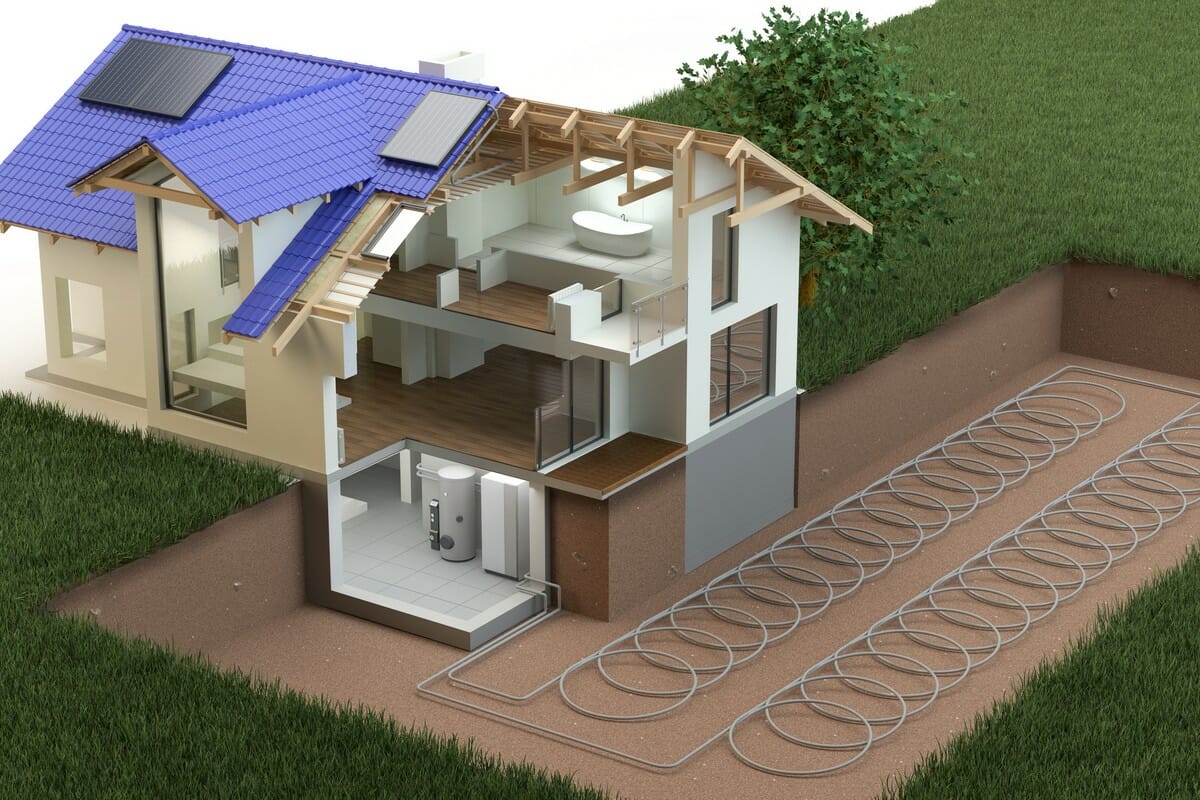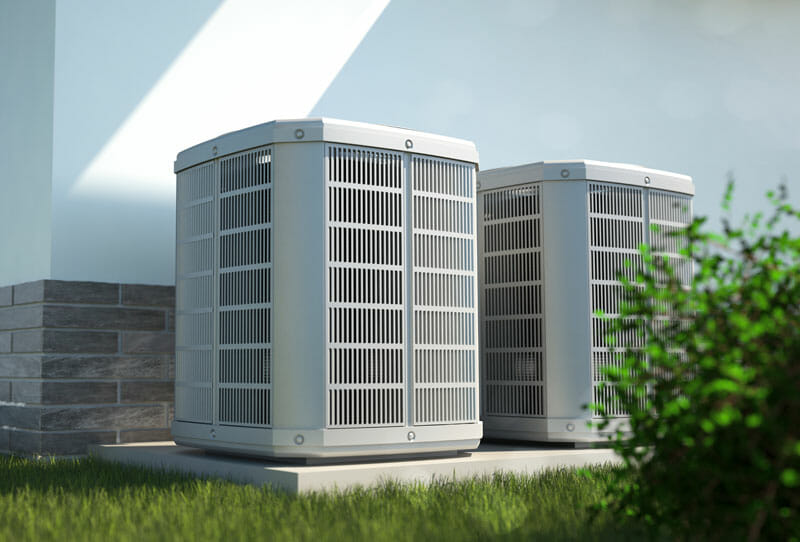Table of Contents
- 1 - How Does a Ground Source Heat Pump Work?
- 2 - What are the Requirements for a Ground Source Heat Pump?
- 3 - Benefits of Ground Source Heat Pumps
- 4 - Ground Source Heat Pump Energy Costs and Savings
- 4.1 - How Much Does a Ground Source Heat Pump Cost?
- 4.2 - Renewable Heat Incentive for Ground Source Heat Pumps
- 4.3 - What are the Maintenance Requirements of a Ground Source Heat Pump?
- 4.4 - How much will a Ground Source Heat Pump Lower my Energy Bills?
- 4.5 - Ground Source Heat Pump Efficiency
- 4.6 - Types of Ground Source Heat Pumps
How Does a Ground Source Heat Pump Work?
A ground source heat pump, also known as a geothermal heat pump, is a central, combination heating and cooling system that transfers heat to or from the ground. It is composed of a network of underground buried water pipes called a ground loop and a ground-level heat pump.
It uses the earth as a source of heat (in winter) or as a heat sink (in summer) on a consistent, continual basis. This system takes advantage of the low ground temperatures to improve performance and reduce the running costs of heating and cooling systems and can be combined with solar energy to create an even more effective geo-solar network.
A ground source heat pump system harnesses natural underground power by driving water through pipes. The heat pump then raises the temperature, and heat is used to deliver heating or hot water to the house.
Ground source heat pumps need electricity to run, but the idea is to use less electrical energy than the heat they produce. In a central heating system, the pump plays the same role as a boiler, but to generate heat, it uses ambient heat from the ground, instead of burning fuel. A ground source heat pump can raise the ground temperature to about 50°C, although the hotter you heat your water, the more electricity you’ll be using.
What are the Requirements for a Ground Source Heat Pump?
The heat pump itself, the ground loop and the distribution system are the fundamental elements of a ground source heat pump system.
Heat Pump
It is the basic element in the ground source heat pump system. It collects heat from the ground loop and, thanks to the compressor, adds some more energy and delivers it to the distribution system.
Ground Loop
The ground loop is the portion of the heat pump system source that differentiates ground source heat pumps from any other form of heat pump system. It essentially absorbs heat from either ground or water where there is a lake or pond nearby and brings it to the heat pump by means of a network of pipes.
The network can be built out in various configurations based on different factors such as the necessary heating and cooling load, ground conditions and available space.
Distribution System
The distribution system carries the heat collected by the heat pump into the building and distributes it through a network of pipes. Using forced air systems, underfloor heating systems, and radiators, that heat is finally released. The distribution system includes a pump that keeps the fluid flowing through the building.
Benefits of Ground Source Heat Pumps
Their low energy consumption levels are one of the main benefits of ground source heat pumps, as they consume 20-50% less energy than conventional heating or cooling systems, so in essence, ground source heat pumps save money. Heat pumps run much cheaper than direct electric heating systems and ground source heat pumps are cheaper than oil boilers to run and, are also cheaper than gas boilers to run.
Heat pumps are safe to use, as there is no ignition involved and no possible harmful gas emissions. Furthermore, ground source heat pumps need less maintenance than heating systems which are based on combustion. They also have a longer life than combustion-based boilers. The ground heat exchanger element has a lifespan of more than 100 years.
Heat pumps are emissions saving. Unlike with burning gas, oil, coal, or biomass, a heat pump generates no carbon emissions at all, as long as they are powered by a renewable source of electricity.
GSHPs are secure, quiet, unobtrusive and out of sight. In some locations, they do not need planning permission for installation. Ground source heat pumps are the only green energy systems capable of taking advantage of the ground’s thermal energy storage properties to transfer heat from summer to winter. Also, a well-designed ground source heat pump system is sure to increase the property’s value for sale.
Ground Source Heat Pump Energy Costs and Savings
The cost of installing a new ground source heat pump will vary depending on a variety of factors including the type of system, the size of your home and the physical attributes of the property. While the upfront cost may be large compared to other heating and cooling technologies, geothermal systems’ long-term savings can often more than justify an installation.
Read on to find out if the savings that you could make from a ground source heat pump are enough to rationalise the cost of purchase and installation.
How Much Does a Ground Source Heat Pump Cost?
Ground source heat pumps vary in size and complexity so it’s hard to determine a standard cost. The Energy Saving Trust (EST) reports that installing one in your home will cost between £10,000 and £18,000. Expect to be at the bottom end of this cost for smaller homes with lower heating and cooling loads. Higher upfront costs are the standard for bigger properties or commercial buildings.
Renewable Heat Incentive for Ground Source Heat Pumps
A ground source heat pump system can save you money in the long run in most situations, but the initial costs can look a little overwhelming. If you’re concerned about the geothermal energy price tag, knowing the reimbursements and discounts that are open to you will help you decide whether you want to invest in this.
For example, financial assistance is available because of the government RHI scheme. The Energy Savings Trust calculates that the RHI scheme could deliver an extra £2,335 to £2,750 a year for properties in England, Scotland and Wales.
With the Government’s domestic Renewable Heat Incentive scheme, if you install a suitable renewable heating system you qualify to receive quarterly cash payments over the course of seven years.
What are the Maintenance Requirements of a Ground Source Heat Pump?
For the most part, ground source heat pumps operate in about the same way as a refrigerator except in reverse, so maintenance is minimal. However, most ground source heat pumps will require an annual inspection by a qualified technician to ensure that they operate within the tolerances of the manufacturer, since a heat pump that is not operating properly may lose up to 25% of its efficiency in both performance and energy consumption.
It is important to point out that if the thermostat is set too low, then the costly auxiliary heater may kick in, so the unit will be using significantly more electricity to operate than it should.
Different manufacturers will specify in their documentation what the exact suggested maintenance and service schedules should be, so it would be advisable to do a bit of research on which units offer the most favourable maintenance requirements before you buy one. Many ground source heat pumps are built to last for over 25 years and after this time many may continue to operate efficiently.
How much will a Ground Source Heat Pump Lower my Energy Bills?
A ground source heat pump costs more to install than an air-source heat pump because it requires that you to dig down to the source of heat, and it involves more complicated heat transfer systems. Depending on the terrain on your property, that can get a little expensive.
However, the operation of a ground-source heat pump is less costly since the ground and water have a fairly constant temperature which helps the heat pump to work efficiently. For this reason, ground source heat pumps can save you between 30% and 40% or more on your utility bill. However, be warned that neglect will reduce the efficiency of a heat pump over time.
These savings will, however, depend on how efficiently your system works, and the type of system you are using, whether you qualify for Renewable Heat Incentive (RHI) payments, how well your home is insulated, how efficiently you use the controls of the system and how you will use the heat produced by the pump.
Ground Source Heat Pump Efficiency
Ground source heat pump absorbs and transfers three or four units of heat per each unit of energy it uses. This implies, in turn, that a well-installed ground source heat pump can be 300% to 400% effective in terms of its electricity consumption. Moreover, there would be 70% lower carbon dioxide emissions at this output stage than for a gas boiler heating system. When green energy provides electricity, carbon emissions can be reduced to zero.
Ground source heat pumps can be installed anywhere in the UK, either using a borehole or by getting heat from a lake or pond. In summer, heat pumps can also be reversed to provide cooling, making them a very efficient source of heat and cooling for any type of property.
Types of Ground Source Heat Pumps
There are several types of heat pumping systems with ground source. Their choices depend on the available conditions. The types are:
Closed Pipe System
This system has three loops in total; two loops on the ground side and one loop as the cabinet of the system that exchanges heat with the other loops that bring heat from the ground. They have longer and larger pipes for proper operation and precision. They also have an extra loop that pumps fluid between the refrigerant loop and the water loop.
They have two more types:
Vertical system: These systems occupy less space as the name suggests but are longer in length and buried deep down into the ground. They are used for multi-storey residential buildings and large commercial development. They are much more expensive.
Horizontal system: They take up more wide space than the vertical systems but are not buried too deep underground. They are also very cost-effective. You will have to ensure that enough space is available for installation.
Pond or Lake System
This system needs to have a source of water close to the installation. The underground pipes run from the building into the body of water. The pipes are concentric coils, preventing the water from freezing.
Open Loop System
This system needs a continuous supply of clean water that can be harnessed to absorb heat from the subterranean water. Thus, water bodies are used to exchange heat between the fluids.
Direct Exchange
Instead of heat exchange by circulation, there is a single loop refrigerant in the direct exchange which is in direct contact with the ground.
It is very important to have the right system installed, whether in offices or in homes. If you do have the right system installed, it will serve as the saver of energy, helping you financially and helping the planet.
Is a Ground Source Heat Pump Suitable for Your Home?
Ground source heat pumps are both an efficient and environmentally friendly investment that can help you save up to 50% on heating bills compared to traditional heating systems. With UK Government incentives available, it has never been easier to save money on heat pumps.
The Renewable Heating Incentive currently pays 19.33 p / kWh of the energy generated by the heat pumps from ground source. This is one of the highest tariffs you can get, second to 19.74 p / kWh for solar thermal panels. Payments are made over seven years, on a quarterly basis.
The amount of funds you earn will depend on a variety of factors – including the equipment you are installing, the current available tariffs for each heating solution and, metering, in some cases. With all this in mind, if you want to save energy while making your home as comfortable as possible, a ground source heat pump will definitely suit your home.
The secret is to ensure that every aspect of this investment is handled by a knowledgeable person, so you’ll enjoy long-term value for your money. If you are interested in knowing more about ground source heat pumps, we’re here to help. Just fill in your details and preferences in the feedback form and we’ll get back to you with quotes that are customised, free, and carry no obligation at all.



